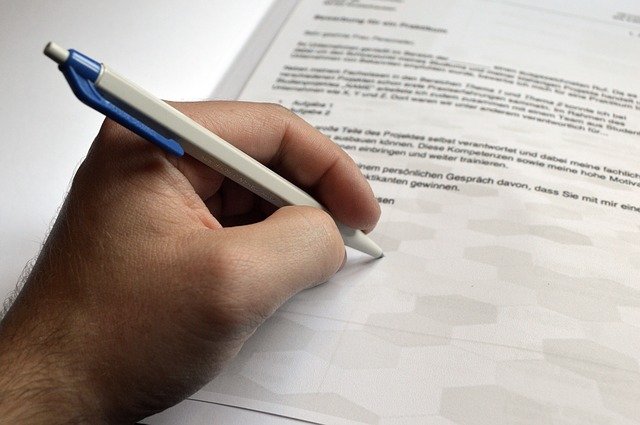
Study Advice
How to Write an Engineering Motivation Letter for a PhD
Read a summary using the INOMICS AI tool
Ok, so the time has come to write your engineering PhD motivation letter. The cursor is blinking on the blank page. Your mind races. What do I write? How do I start? How do I phrase it? It can be a challenge, especially for us engineers who may not enjoy the written word as much as other academics do. But competition for some PhD places can be fierce, especially at good universities. Getting the motivation letter right is one of the most important parts of your application, so don't leave it until the last minute.
 To help you out with what can be a stressful part of the application procedure, we've compiled a list of the essential components of an engineering motivation letter, including the structure, the format, and the nitty-gritty of the content.
To help you out with what can be a stressful part of the application procedure, we've compiled a list of the essential components of an engineering motivation letter, including the structure, the format, and the nitty-gritty of the content.
Basic Structure and Style
The first thing to realise is there's a big difference between the PhD motivation letter you should write for universities in North America and European universities. Typically, American universities expect to hear more about your general life, whereas European ones prefer to keep things mainly focused on your academic and work achievements. As a general rule of thumb:
- America – 70% life skills, accomplishments, 30% academic/practical/work
- Europe – 30% life skills, accomplishments, 70% academic/practical/work
The format
Your letter should follow a standard formal letter format and should:
- be no more than 500 words (approx. one typed page of A4)
- be written in a clear font such as Arial or Calibri
- have a font size of 11 or 12
- consist of short easy-to-read and understand paragraphs
- use sub-headings and bullet points to break up the text
- be polite and formal, but not too wordy
Readability is a key factor in writing a successful motivation letter. Even though you're addressing academics, it's best to keep the language as simple as possible. Remember, this is a letter, not an essay. The professors may have to read dozens of these letters and want to find out about you as easily as possible, without having to wade through waffle, clichés or pompous-sounding sentences. Microsoft Word has a handy built-in readability checker (based on the Flesch-Kincaid test) and you want the "reading ease" score to be between 60 and 70 points to hit the right spot.
The structure
A recommended overall structure for the letter is as follows:
- A brief (1 or 2 sentences) introduction
- Your motivation for applying to do a PhD (personal statement)
- Your academic achievements and relevant life experiences
- The impact you hope to make with your research
- Your future career plans
Before we move on to looking at the actual content of your letter, just a quick note that should really go without saying – stick to the facts. Never be tempted to make things up or "embroider the truth". It's not only unethical but if you're accepted on the course and your dishonesty is revealed at a later date, you could waste all that time and effort, not to mention your reputation will be in tatters. It's not worth it.
Suggested Opportunities
- Summer School
- Posted 1 day ago
BSE Summer School 2025: Economics, Finance, Data Science, and related fields
Starts 23 Jun at Barcelona School of Economics in Barcelona, Spain
- Conference
- Posted 4 days ago
42nd RSEP International Conference on Economics, Business and Finance
Between 19 Sep and 20 Sep in Madrid, Spain
Content of the Engineering Motivation Letter
Don't underestimate practical experience
Let's face it, engineering is a hands-on subject, no matter which branch you specialise in. The single biggest mistake that graduates make when applying for an engineering PhD, is focussing entirely on their academic achievements and neglecting any practical or "in-the-field" experience. Make a list of any relevant work experience, field trips, projects, etc. Anything that had an engineering element to it can be included. A good tip is to go back as far as possible. Joined a robotics club in secondary school? Write it down. Helped a neighbour build their house extension? Write it down. Had a summer job with a construction company? You get the picture. Even if you decide not to use half of it, listing all of these things out will give you some ideas of relevant skills you can mention.
Be specific
Another mistake people commonly make is to list their skills without providing any evidence, or just generally making vague statements. Don't simply state: “I work well in a team”. Give an example: “During my time at XYZ Construction Ltd, I worked closely with various team members to plan and build a gherkin-shaped tower block”. Don't say: “I enjoyed my Environmental Engineering undergraduate degree”. Be very specific about what you enjoyed: “As part of my degree course, I studied the spread and effect of subsoil pollution, which I found really interesting. So interesting in fact, that I spent my summer working for a soil remediation company.”
Show a bit of personality
It's ok to add a bit of character to the letter. Avoid jokes and sarcasm, but you can phrase things in a way that adds some sparkle. Include some "insider" references that only a fellow engineer would understand, for example. A great way to get your letter to stand out from the crowd is to highlight how your personality has helped you to overcome difficulties or achieve things related to engineering. A good example of this could be if you have worked on any relevant community or voluntary projects.
Show them that you're perfectly suited to the rigours of a PhD
A PhD is very different from undergraduate and postgraduate studies and requires different skills. You need to be self-motivated, disciplined, industrious, resourceful and focussed. Try to think of events in your life that demonstrate these qualities and make sure to mention them.
Talk about your plans
Towards the end of your letter, make sure you mention what your long-term plans are. This shows that you are focused on engineering as a career and that you’ll work hard to achieve results. Talk about any relevant work experience you’ve had to date – paid or unpaid. Also, mention any engineering societies or institutions that you’re a member of or plan to join.
Gentle Persuasion Techniques
We're not going to go in-depth into the psychology of persuasion here, but there are some little-known copywriting (i.e. advertising) "secrets" that you can employ to influence them to accept you. First of all, come up with a concrete idea of what they are looking for in a student. Once you have this fixed in your mind, include a sentence or two that shows you understand this and that you're the person they've been waiting for. For example, if you think they're looking for somebody creative with good design skills and also demonstrates people skills, you could include something like this in your introduction: “You're looking for a high-calibre student with a keen interest in design. During my undergraduate studies, I took part in several extracurricular design projects which involved coordinating and working with a small team of engineers.”
Another copywriting "trick" is to use powerful verbs to inspire or evoke an emotional response – think Nike’s slogan "Just Do It". We’re not suggesting you include a cheesy slogan, but try to use powerful verbs such as:
- I did…
- I made sure…
- I focused...
- I endeavoured…
- I innovated...
Also, if you remember your school English lessons, they may have mentioned passive and active voice. Make sure that the majority of your phrases use the active voice. Here’s an example:
- Passive voice: “I was able to make a difference.”
- Active voice: “I made a difference.”
Finally, try to end with an upbeat message. In advertising, this is known as a call to action – a rousing final pitch that encourages the person to take a specific action. In a motivation letter, it’s a good idea to summarise the key things that make you suitable for the course, then close with something like: “Please don’t hesitate to contact me if you need any more information and I look forward to your response.”










